

Collaborating Nationally. Empowering Locally.
Flooding remains the leading cause of natural-disaster loss across the United States. The Interagency Flood Risk Management (InFRM) team brings together Federal Partners with mission areas of hazard mitigation, emergency management, floodplain management, natural resources management or conservation to leverage the skillsets, resources and programs to determine the needs of communities and define solutions and implement measures to reduce long term flood risk throughout the States of Arkansas, Louisiana, New Mexico, Oklahoma and Texas.
In 2014, the Federal Emergency Management Agency (FEMA) began sponsorship of the InFRM team initiative to allow Federal teams across the States of Texas, Oklahoma, New Mexico, Louisiana and Arkansas to better align and integrate. Currently, the InFRM team is comprised of FEMA, US Army Corps of Engineers, US Geological Survey, and the National Weather Service. No single agency has all the answers, but through a coordinated effort of multiple programs and various perspectives, a cohesive solution can be found. By applying their shared knowledge, the InFRM team can also enhance response and recovery efforts when flood events do occur.
While floods are impossible to prevent completely, and there is no way to guarantee protection of property, loss of life can be greatly reduced when communities have access to good data, practice sound land use, floodplain management and development practices and incorporate warning systems. Local communities can partner with the InFRM team to investigate solutions to reduce their communities flood risk.
This effort will be accomplished by an interagency coalition comprised of the Federal Emergency Management Agency, U.S. Army Corps of Engineers, U.S. Geological Survey, and the National Weather Service. These agencies are currently in partnership through the group known as the Interagency Flood Risk Management (InFRM) team and this effort will be undertaken by this group. The InFRM team will reach out to state and local government organizations as well as private industry to aid in moving this monumental effort forward.
InFRM operates under the umbrella of the Integrated Water Resources Science and Services (IWRSS), a business model for interagency collaboration. IWRSS brings a consortium of United States federal agencies with complementary water resources missions together to share resources to help solve the nation's water resources issues. In 2011 several Federal agencies came together and initiated an Interagency Memorandum of Understanding to create IWRSS. IWRSS's overarching objective is to enable and demonstrate a broad, integrative national water resources information system to serve as a reliable and authoritative means for adaptive water-related planning, preparedness and response activities. The goals are to:
The members of IWRSS are the same four United States federal agencies as InFRM: USACE, USGS, NOAA, and FEMA.

Base Level Engineering is a watershed-wide engineering modeling method that leverages high resolution ground elevation, automated model building techniques, and manual model review to prepare broad and accurate flood risk information for FEMA to assess its current flood hazard inventory. Base Level Engineering prepares flood risk information with scalable engineering, allowing FEMA to both assess its current flood hazard inventory and expand the coverage and availability of flood risk information to communities and individuals interested in reviewing their potential flood risk.
Goal: Centralized and available flood hazard analysis to support floodplain management activities and development review, while increasing risk awareness for individuals.
Take a video tour of the Estimate Your Base Flood Elevation application.
Methods:
Base Level Engineering provides modeling and floodplain extents to assess these unknown and unverified mileage. Additionally, Base Level Engineering results have been prepared to meet all technical, engineering and mapping standards so that it may be used to update FIRMs in the case that the current inventory is not able to be validated.
Watershed-wide Base Level Engineering assessments develop the following flood risk information, available for download through this site:
Additional items may be available for download to include Hazus analysis (county or HUC8 level), Flood Risk Report, and/or Base Level Engineering Technical Report.
FEMA Region 6 is partnered with the InFRM team to work towards a future state where communities throughout the Region have a minimum dataset that describes the flood risk in their vicinity and allows them to determine a Base Flood Elevation. Base Level Engineering information does not replace the information shown on any current effective FIRM panel in a community, but may be used to identify areas a significant change in the floodplain delineation, water surface elevation or depth since the last flood risk study (both reduction and expansion) should be investigated with communities further.
FEMA will coordinate with local communities prior to initiating an update to the existing flood hazard information shown on FIRM panels across the nation.
| Arkansas |
Christy Weiser Christy.Weiser@fema.dhs.gov 202.705.9624 |
Shawn Jackson Shawn.Jackson@agriculture.arkansas.gov 501.682.3959 |
Whit E. Montague Whitney.Montague@agriculture.arkansas.gov 501.682.3969 |
| Louisiana |
Alan Johnson Alan.Johnson@fema.dhs.gov 225.620.7062 |
Cindy O'Neal cindy.oneal@la.gov 225.379.3005 |
Susan Veillon Susan.Veillon@la.gov 225.379.3017 |
| Oklahoma |
Tarah (Baumgartner) Graham Tarah.Baumgartner@fema.dhs.gov 202.878.1697 |
Jon Phillips Jon.Phillips@owrb.ok.gov 405.255.9145 |
Aaron Milligan Aaron.Milligan@owrb.ok.gov 405.530.8800 |
| New Mexico |
Brittany Brush Brittany.Brush@fema.dhs.gov 202.285.8183 |
Loretta Hatch Loretta.Hatch@state.nm.us 505.377.1616 |
Shawn Penman spenman@edac.unm.edu 505.277.3622 x227 |
| Texas |
Larry Voice Larry.Voice@fema.dhs.gov 940.898.5419 |
Manuel J. Razo manuel.razo@twdb.texas.gov 512.475.1850 |
|
| Estimated BFE Viewer |
Diane Howe Diane.Howe@fema.dhs.gov 940.435.9588 |
The InFRM Flood Decision Support Toolbox (FDST) is an interactive web application (WebApp) which:
Take a video tour of the Flood Decision Support Toolbox.
Flood inundation map libraries at USGS streamgaging stations and NWS Advanced Hydraulic Prediction Service (AHPS) forecast points will be built using existing engineering-scale or FEMA base level engineering-scale specifications. The Hydrologic Engineering Center’s (HEC) River Analysis System (RAS) will be the primary numerical modeling tool employed to prepare the inundation mapping products. HEC-RAS includes the capability for steady flow analysis, unsteady flow analysis and 2-dimensional modeling. HEC-RAS is the current standard for river hydraulic modeling across the United States. A vast array of existing HEC-RAS models are available for various river systems across Texas including
Additionally, the FDST will incorporate NWS river forecast models that estimate the quantity and timing of water flowing through selected stream reaches in the United States during flooding events. These forecast models:
The following is a high-level listing of the steps that will be required for execution of this program.
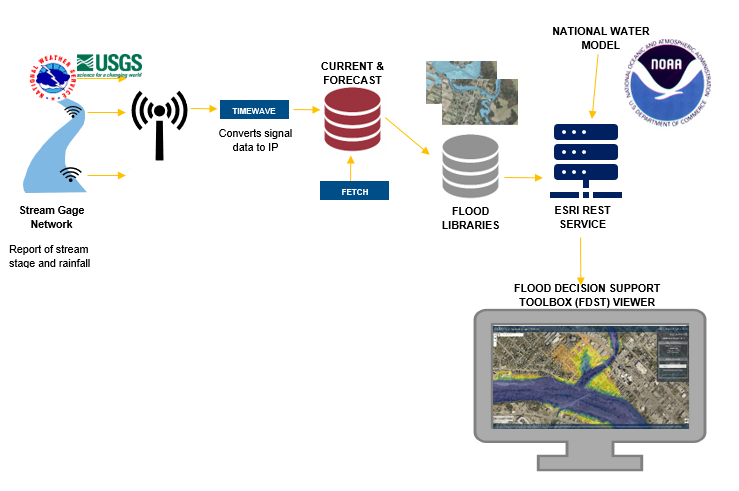
Potential mapping partners may download the FDST Map Submission Guidelines to determine the modeling requirements and steps needed to generate map libraries for their area of interest. The FDST is a ‘living’ viewer that will be continually updated with new models and improvement to the interface. As such, the mapping guidelines will also be a ‘living’ document that will be updated with each update to the web application. Please continue to check the website for the most recent version of the guidelines.
As hydrology remains the single largest source of uncertainty in our understanding of flood risk, the InFRM team has been performing Watershed Hydrology Assessments (WHAs) to update flood risk estimates in large, complex river basins using suites of models developed by USACE.
The InFRM WHAs are performed by an expert team of engineers and scientists from multiple federal agencies using the latest advances in hydrologic science and technology. WHAs examine the hydrology across the entire basin, reviewing non-stationary influences, such as regulation, land use changes, and climate variation, to ensure all variables affecting flood risk in the watersheds are considered. The multi-layered analysis of the WHAs employs a range of hydrologic methods, including rainfall runoff modeling, statistical hydrology, period-of-record simulations, and reservoir analyses, and then compares the results of those methods to previous studies and to one another.
The goal of the WHAs is to produce consistent 1% annual chance (100-yr) and other frequency flows across the river basin, based on all available hydrologic information. The final recommendations of the WHAs are formulated through a rigorous review process which includes technical investigations, external peer reviews, stakeholder input, and collaboration between all of the InFRM subject matter experts.
River basins within the region are selected for hydrology assessments based on watersheds where USACE already has sufficiently detailed modeling products available as a starting point for the assessments and where FEMA had future floodplain mapping activities scheduled.
InFRM WHAs have been completed for the following river basins in FEMA Region 6:
The final reports and appendices for these studies can be downloaded from the links to the right.
InFRM WHAs are currently underway for the following river basins:
Additional basins will be added to the program as funding allows.
As a result of the level of investment, analyses, and collaboration that go into the WHAs, their results are recommended as the best available estimate of flood risk for the studied streams in the river basin, and they provide suggestions for areas where the current flood hazard information may need to be updated. The results from the WHAs can also be used to plan new infrastructure and safely locate new neighborhoods and other urban development. Furthermore, the models and data used to produce these flood risk estimates are available upon request, at no charge, to communities, local stakeholders, and architecture engineering firms.
For more information from any of these studies, please use the link below:
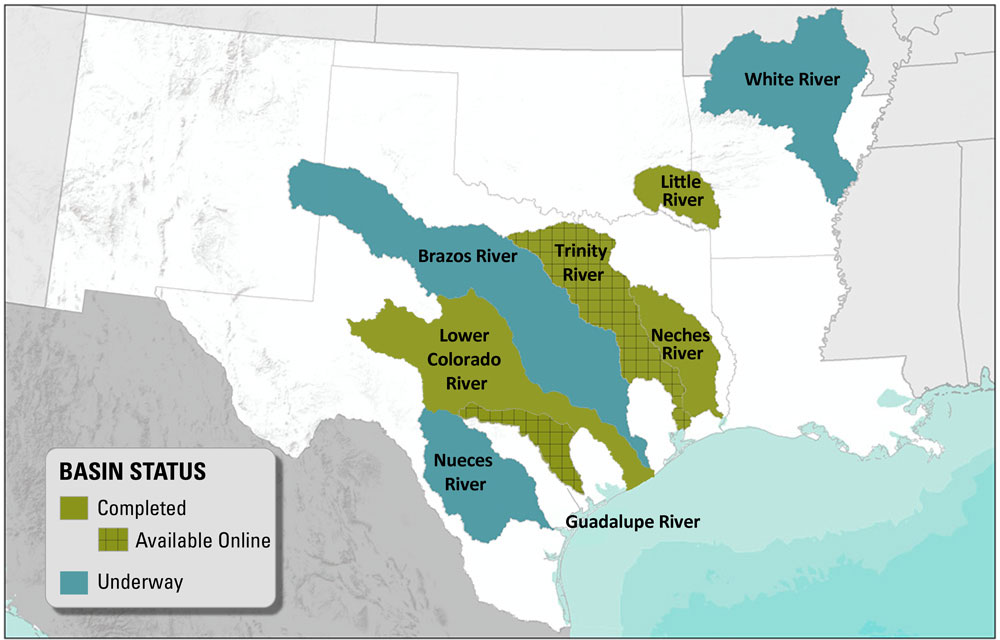
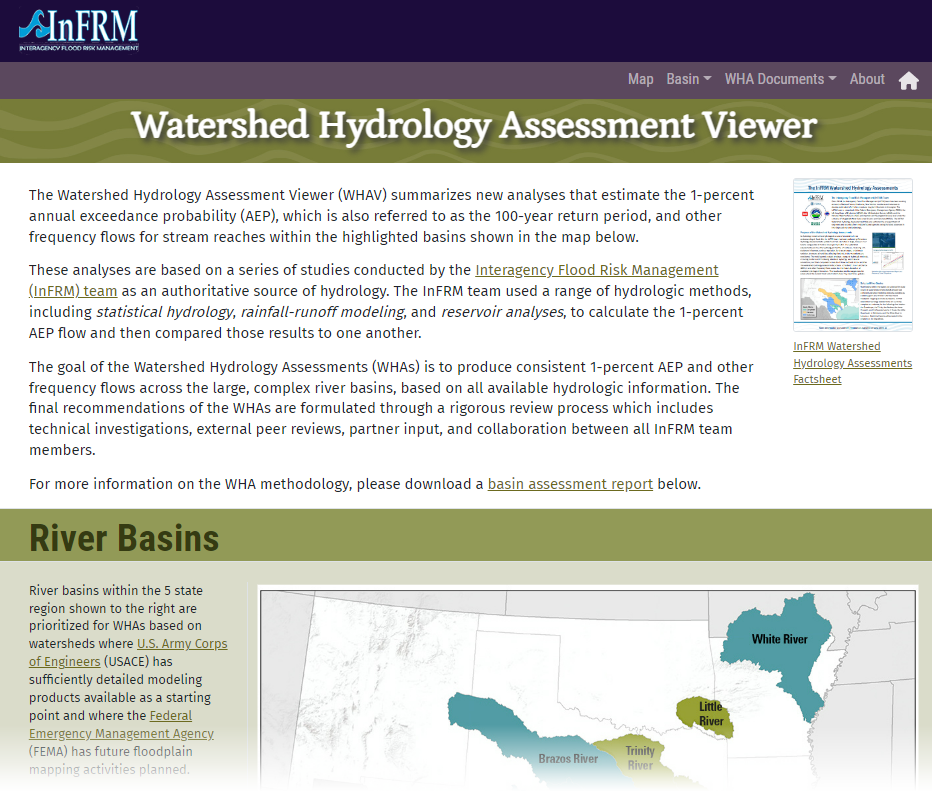
On September 27 of 2018, NOAA’s Hydrometeorological Design Studies Center released a new study called Atlas 14 Volume 11: Precipitation Frequency for Texas. The updated precipitation estimates supersede those currently available for Texas from the 1960s and 1970s. Atlas 14 data help state and local communities prepare for potential flooding and minimize weather's impacts on lives and livelihoods. Precipitation frequency estimates are used by engineers and planners to bring knowledge of flood hazards into land use and development decisions, including managing and designing stormwater infrastructure. Estimates are also used in hydrologic models to delineate flood risks and manage development in floodplains for FEMA’s National Flood Insurance Program. The InFRM team, led by USACE Fort Worth District, helped raise funds and manage this project to see that Texas has the same updated precipitation data as the majority of the nation. The new NOAA Atlas 14 estimates represent vastly improved data in terms of both period of record and station density, state of the art statistical techniques, and a new approach to spatial interpolation that accounts for variation in terrain.
Find Out MoreThe NOAA Atlas 14 program provides:
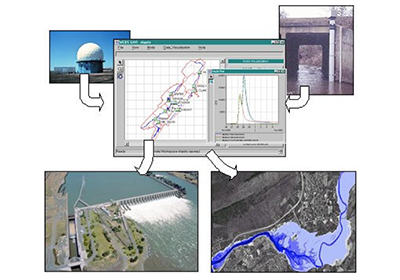
Automated information system used by the USACE to support its water control management mission.
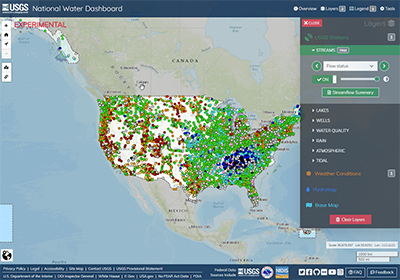
See provisional real-time water data at USGS observation stations in context with current weather and hazard conditions.
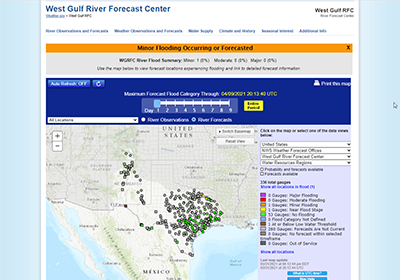
View forecast locations experiencing flooding with links to
detailed forecast
information.
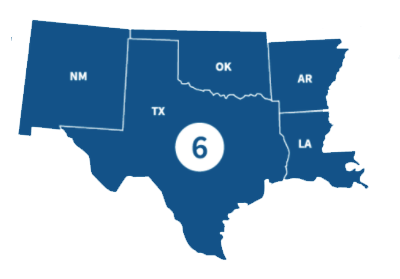
Oversees federal emergency management for the states of Arkansas, Louisiana, New Mexico, Oklahoma and Texas, and 68 federally recognized tribal nations.
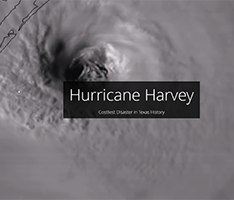
Scroll through a story map about Hurrican Harvey:
the costliest disaster in Texas history.
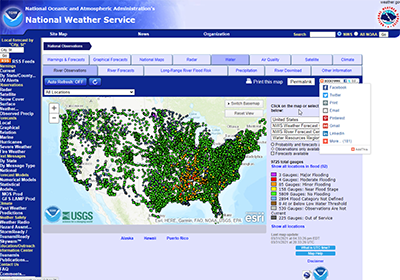
See forecast tools that show the magnitude and uncertainty of occurrence of floods or droughts, from hours to days and months, in advance.
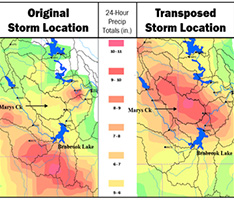
See example study with informative, relatable, and non-regulatory data to better understand and mitigate flood risk.
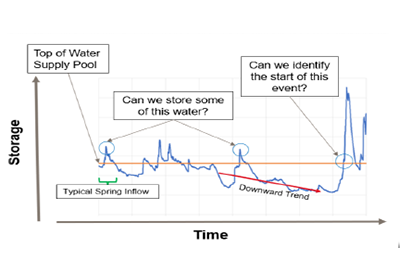
Learn how weather and streamflow forecasts can aid decisions in reservoir operations and what lessons have been learned.
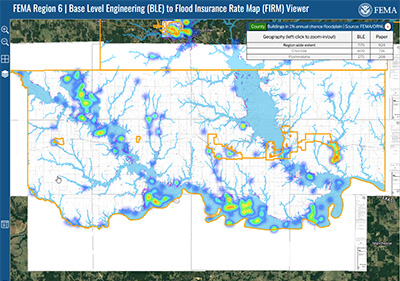
FEMA’s Region 6 BLE-to-FIRM Viewer (B2F) uses a geospatial database to help communities and counties review effective flood hazard areas that may be updated with Base Level Engineering (BLE) data.
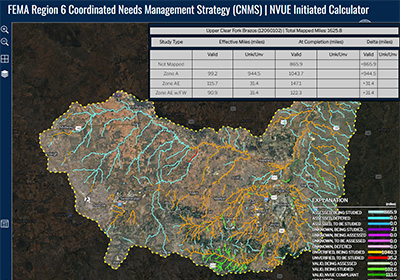
FEMA’s Region 6 Coordinated Needs Management Strategy (CNMS) uses a geospatial database to identify and track flood hazard study lifecycle and mapping needs within the flood hazard mapping program.